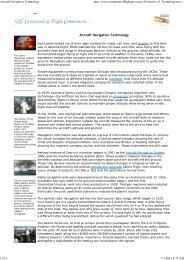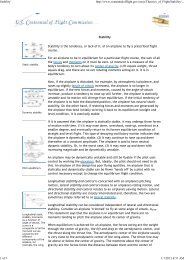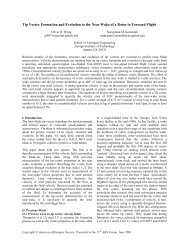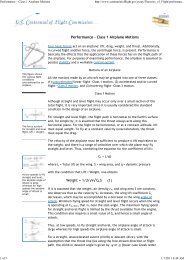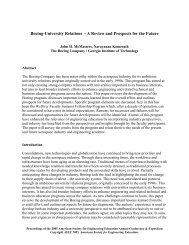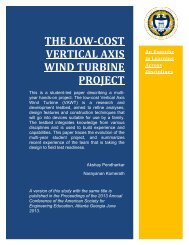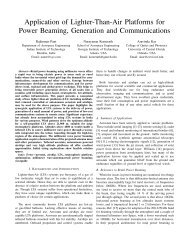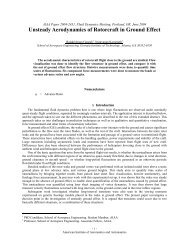Skin-Friction Drag An important aerodynamic force during low ...
Skin-Friction Drag An important aerodynamic force during low ...
Skin-Friction Drag An important aerodynamic force during low ...
- No tags were found...
You also want an ePaper? Increase the reach of your titles
YUMPU automatically turns print PDFs into web optimized ePapers that Google loves.
<strong>Skin</strong>_<strong>Friction</strong>http://www.centennialofflight.gov/essay/Theories_of_Flight/<strong>Skin</strong>_Frict...2 of 3 1/1/2011 8:35 AMA the velocitybecomes a constantvalue V. The layer offluid where thevelocity is changingfrom zero to aconstant value isknown as theboundary layer.Figure (c) compareslaminar andturbulent f<strong>low</strong>s. Asis usual for turbulentf<strong>low</strong>, there is arandom motion inthe boundary layer.Real fluid f<strong>low</strong> aboutan airfoil. Thethickness of theboundary layers andwake are greatlyexaggerated. Thebottom f<strong>low</strong> along<strong>low</strong>er surface is thesame as on theupper surface.Figure (a) comparesthe ideal fluid casestatic-pressuredistribution at theairfoil surface andcenterlinestreamline with thereal fluid case.Figure (b) illustratesthat, in the idealfluid case, the netstatic-pressure<strong>force</strong> acting on thefront surface of theairfoil (up to theshoulder) parallel tothe free streamexactly opposesand cancels thatacting on the rearsurfaces of theairfoil. In the realfluid case, shown infigure (c), the netresult is a drag <strong>force</strong>due to theasymmetricpressure distributionaircraft wing is generally less than a centimeter (2.5 inches). Yet, the velocitymust vary from zero at the surface of the wing to hundreds of meters per secondat the outer edge of the boundary layer. It is evident that tremendous shearing<strong>force</strong>s (internal friction) must be acting in this region. This gives rise to theskin-friction drag.Applied to an airfoil in a real airf<strong>low</strong>, the same free-stream velocity V¥ andfree-stream static pressure p¥ apply. The field of air ahead of the airfoil is onlyslightly modified and for all practical purposes, the velocities and staticpressures are the same as for the ideal fluid case. Again a stagnation point (apoint with no motion) occurs at the leading edge of the airfoil and the pressurereaches its maximum value of p t at this point (total or stagnation pressure).From this point on along the airfoil, the picture changes.As noted earlier in the example of the flat plate, a boundary layer begins toform because of viscosity. This boundary layer is very thin and outside of it, thef<strong>low</strong> acts very much like that of an ideal fluid. Also, the static pressure actingon the surface of the airfoil is determined by the static pressure outside theboundary layer. This pressure is transmitted through the boundary layer to thesurface and thus acts as if the boundary layer were not present at all. But theboundary layer feels this static pressure and will respond to it.Over the front surface of the airfoil up to the shoulder, an assisting favorablepressure gradient exists (pressure decreasing with distance downstream). Theairf<strong>low</strong> speeds up along the airfoil. The f<strong>low</strong> is laminar and a laminar boundarylayer is present. This laminar boundary layer grows in thickness along theairfoil. When the shoulder is reached, however, the air molecules are movings<strong>low</strong>er than in the ideal fluid case. This is an unfavorable condition because theprevious ideal f<strong>low</strong> just came to rest at the trailing edge of the airfoil. It wouldappear now, with viscosity present, that the f<strong>low</strong> will come to rest at somedistance before the trailing edge is reached.As the airf<strong>low</strong> moves from the shoulder to the rear surface of the airfoil, thestatic-pressure gradient is unfavorable (increasing pressure with downstreamdistance). The air molecules must push against both this unfavorable pressuregradient and the viscous <strong>force</strong>s. At the transition point, the character of theairf<strong>low</strong> changes and the laminar boundary layer quickly becomes a turbulentboundary layer. This turbulent boundary layer continues to thicken downstream.Pushing against an unfavorable pressure gradient and viscosity is too much forthe airf<strong>low</strong>, and at some point, the airf<strong>low</strong> stops completely. The boundarylayer has stalled short of reaching the trailing edge. (Remember that the airf<strong>low</strong>reached the trailing edge before stopping in the ideal fluid case.)This stall point is known as the separation point. All along a line starting fromthis point outward into the airf<strong>low</strong>, the airf<strong>low</strong> is stalling. Beyond this line, theairf<strong>low</strong> is actually moving backward, upstream toward the nose before turningaround. This is a region of eddies and whirlpools and represents “dead” air thatis disrupting the f<strong>low</strong> field away from the airfoil. Thus, the airf<strong>low</strong> outside thedead air region is <strong>force</strong>d to f<strong>low</strong> away and around it. The region of eddies iscalled the wake behind the airfoil.Up to the separation point, the difference between the static-pressuredistribution for ideal fluid f<strong>low</strong> and real airf<strong>low</strong> is not very large but onceseparation occurs, the pressure field in greatly modified. In the ideal fluid case,the net static-pressure <strong>force</strong> acting on the front surface of the airfoil (up to theshoulder) parallel to the free stream exactly opposed and canceled that actingon the rear surfaces of the airfoil. Under real airf<strong>low</strong> conditions, however, thissymmetry and cancellation of <strong>force</strong>s is destroyed. The net static-pressure <strong>force</strong>



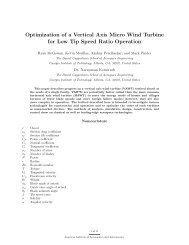
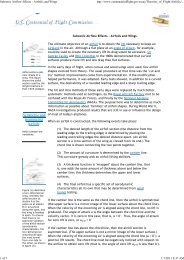

![p density of fluid, kg/m3 [Greek letter rho] V mean velocity of fluid, m ...](https://img.yumpu.com/50595898/1/184x260/p-density-of-fluid-kg-m3-greek-letter-rho-v-mean-velocity-of-fluid-m-.jpg?quality=85)
